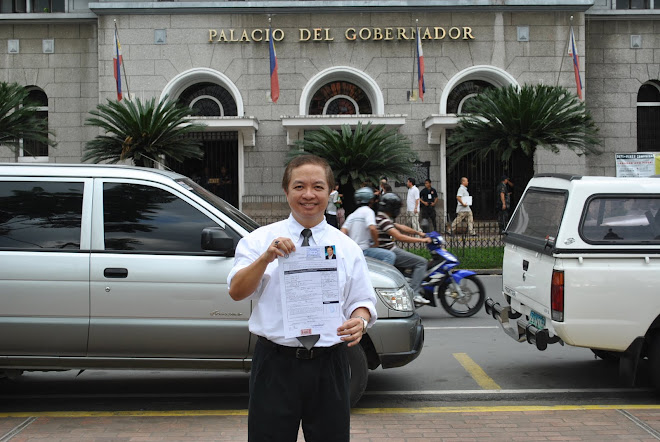Tuesday, October 28, 2008
728-million fertilizer scam
WHAT WENT BEFORE
728-million fertilizer scam, Philippine Daily Inquirer
MANILA, Philippines—In 2003, Marlene Esperat, then an employee of the Department of Agriculture’s resident ombudsman in Central Mindanao, filed a graft complaint against Agriculture Secretary Arthur Yap, then Undersecretary Jocelyn Bolante, and several others in connection with alleged irregularities in a P432-million fertilizer deal.
Esperat said the fertilizers bought were overpriced and procured through a negotiated contract instead of a public bidding.
Two months before the May 2004 presidential election, Sen. Panfilo Lacson, a presidential candidate, accused President Gloria Macapagal-Arroyo, herself running for election, of “virtual vote-buying” by authorizing the release of P728 million to favored officials to buy farm inputs like fertilizer and pesticide for their constituents, as part of the Ginintuang Masaganang Ani project.
Resignation
After the election, former Solicitor General Frank Chavez filed a plunder case against Ms Arroyo in connection with Lacson’s accusation. Chavez named Bolante as one of those who signed the papers for the release and disposition of the funds.
Bolante quit his post at the Department of Agriculture in September 2004, ostensibly because of his election as a director of Rotary Club International.
In the same month, the Ombudsman dropped Esperat’s graft charges against Yap, but declared as “sufficient in form and substance” the graft complaint against Bolante.
(Esperat, who later became a journalist, was shot dead in her home in Sultan Kudarat on March 24, 2005. Three men were convicted of her murder, but the suspected masterminds—officials of the agriculture department office in Central Mindanao already charged by the justice department—remain at large.)
In October 2005, the Senate committee on agriculture chaired by then Sen. Ramon Magsaysay Jr. opened an inquiry into the fertilizer fund controversy. Bolante did not show up during the first hearing, and flew to Los Angeles hours before the second hearing on Oct. 26.
Magsaysay sought the help of the US Embassy and Rotary Club International in locating Bolante, who was also a no-show at the Nov. 17 and 24 hearings.
Bolante reportedly returned to the Philippines on Dec. 5, but was able to leave again on Dec. 11, days after the Bureau of Immigration put him on its watch list. He left on board a Cathay Pacific flight for Hong Kong en route to the United States.
Arrest order
On Dec. 13, the Senate cited Bolante for contempt and ordered his arrest.
In January 2006, he filed a petition to the Supreme Court through the Philippine Consul in Chicago, asking that the Senate be stopped from implementing the arrest order.
He said he was willing to attend the Senate inquiry, but again snubbed the Jan. 31 and Feb. 2 hearings.
In March, the Senate’s blue ribbon and agriculture committees released a report recommending the filing of criminal and administrative charges against Bolante and other agriculture officials.
The report also said Ms Arroyo should be “held accountable” for the mismanagement of the fertilizer fund.
On July 7, 2006, Bolante was detained on arrival at the Los Angeles International Airport on grounds of an invalid non-immigrant (B1/B2) visa. (A US court document given to the Philippine Daily Inquirer in September 2006 said the US Embassy in Manila cancelled Bolante’s visa upon the Senate’s request.)
Bolante was held at the San Pedro Detention Center on Terminal Island, 48 kilometers from Los Angeles, then transferred to the Kenosha Rehabilitation Center in Wisconsin.
Court battle
On Aug. 4, the LA-based federal judge reviewing Bolante’s asylum case granted his petition to transfer the case to an immigration court in Chicago.
Bolante testified before that court on Nov. 10, saying his life would be endangered if he returned to the Philippines.
It rejected his petition in February 2007, citing lack of proof that he was “suffering from a well-grounded fear of persecution.”
Bolante took the case to the US Court of Appeals, which also denied his petition on Aug. 27 this year.
He again experienced defeat on Sept. 3, when the US District Court for the Eastern District of Wisconsin dismissed his petition for habeas corpus.
On Oct. 23, the US Embassy confirmed that the US Department of Homeland Security had issued a “removal order” on Bolante, and that he could be deported anytime.
Bolante’s lawyer said his client had decided to yield to the order. Inquirer Research
728-million fertilizer scam, Philippine Daily Inquirer
MANILA, Philippines—In 2003, Marlene Esperat, then an employee of the Department of Agriculture’s resident ombudsman in Central Mindanao, filed a graft complaint against Agriculture Secretary Arthur Yap, then Undersecretary Jocelyn Bolante, and several others in connection with alleged irregularities in a P432-million fertilizer deal.
Esperat said the fertilizers bought were overpriced and procured through a negotiated contract instead of a public bidding.
Two months before the May 2004 presidential election, Sen. Panfilo Lacson, a presidential candidate, accused President Gloria Macapagal-Arroyo, herself running for election, of “virtual vote-buying” by authorizing the release of P728 million to favored officials to buy farm inputs like fertilizer and pesticide for their constituents, as part of the Ginintuang Masaganang Ani project.
Resignation
After the election, former Solicitor General Frank Chavez filed a plunder case against Ms Arroyo in connection with Lacson’s accusation. Chavez named Bolante as one of those who signed the papers for the release and disposition of the funds.
Bolante quit his post at the Department of Agriculture in September 2004, ostensibly because of his election as a director of Rotary Club International.
In the same month, the Ombudsman dropped Esperat’s graft charges against Yap, but declared as “sufficient in form and substance” the graft complaint against Bolante.
(Esperat, who later became a journalist, was shot dead in her home in Sultan Kudarat on March 24, 2005. Three men were convicted of her murder, but the suspected masterminds—officials of the agriculture department office in Central Mindanao already charged by the justice department—remain at large.)
In October 2005, the Senate committee on agriculture chaired by then Sen. Ramon Magsaysay Jr. opened an inquiry into the fertilizer fund controversy. Bolante did not show up during the first hearing, and flew to Los Angeles hours before the second hearing on Oct. 26.
Magsaysay sought the help of the US Embassy and Rotary Club International in locating Bolante, who was also a no-show at the Nov. 17 and 24 hearings.
Bolante reportedly returned to the Philippines on Dec. 5, but was able to leave again on Dec. 11, days after the Bureau of Immigration put him on its watch list. He left on board a Cathay Pacific flight for Hong Kong en route to the United States.
Arrest order
On Dec. 13, the Senate cited Bolante for contempt and ordered his arrest.
In January 2006, he filed a petition to the Supreme Court through the Philippine Consul in Chicago, asking that the Senate be stopped from implementing the arrest order.
He said he was willing to attend the Senate inquiry, but again snubbed the Jan. 31 and Feb. 2 hearings.
In March, the Senate’s blue ribbon and agriculture committees released a report recommending the filing of criminal and administrative charges against Bolante and other agriculture officials.
The report also said Ms Arroyo should be “held accountable” for the mismanagement of the fertilizer fund.
On July 7, 2006, Bolante was detained on arrival at the Los Angeles International Airport on grounds of an invalid non-immigrant (B1/B2) visa. (A US court document given to the Philippine Daily Inquirer in September 2006 said the US Embassy in Manila cancelled Bolante’s visa upon the Senate’s request.)
Bolante was held at the San Pedro Detention Center on Terminal Island, 48 kilometers from Los Angeles, then transferred to the Kenosha Rehabilitation Center in Wisconsin.
Court battle
On Aug. 4, the LA-based federal judge reviewing Bolante’s asylum case granted his petition to transfer the case to an immigration court in Chicago.
Bolante testified before that court on Nov. 10, saying his life would be endangered if he returned to the Philippines.
It rejected his petition in February 2007, citing lack of proof that he was “suffering from a well-grounded fear of persecution.”
Bolante took the case to the US Court of Appeals, which also denied his petition on Aug. 27 this year.
He again experienced defeat on Sept. 3, when the US District Court for the Eastern District of Wisconsin dismissed his petition for habeas corpus.
On Oct. 23, the US Embassy confirmed that the US Department of Homeland Security had issued a “removal order” on Bolante, and that he could be deported anytime.
Bolante’s lawyer said his client had decided to yield to the order. Inquirer Research
Subscribe to:
Post Comments (Atom)










No comments:
Post a Comment